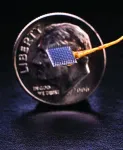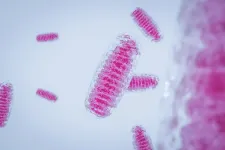(Press-News.org) Scientists are exploring a number of ways for people with disabilities to communicate with their thoughts. The newest and fastest turns back to a vintage means for expressing oneself: handwriting.
For the first time, researchers have deciphered the brain activity associated with trying to write letters by hand. Working with a participant with paralysis who has sensors implanted in his brain, the team used an algorithm to identify letters as he attempted to write them. Then, the system displayed the text on a screen - in real time.
The innovation could, with further development, let people with paralysis rapidly type without using their hands, says study coauthor Krishna Shenoy, a Howard Hughes Medical Institute Investigator at Stanford University who jointly supervised the work with Jaimie Henderson, a Stanford neurosurgeon.
By attempting handwriting, the study participant typed 90 characters per minute - more than double the previous record for typing with such a "brain-computer interface," Shenoy and his colleagues report in the journal Nature on May 12, 2021.
This technology and others like it have the potential to help people with all sorts of disabilities, says Jose Carmena, a neural engineer at the University of California, Berkeley, who was not involved in the study. Though the findings are preliminary, he says, "it's a big advancement in the field."
Brain-computer interfaces convert thought into action, Carmena says. "This paper is a perfect example: the interface decodes the thought of writing and produces the action."
Thought-powered communication
When an injury or disease robs a person of the ability to move, the brain's neural activity for walking, grabbing a cup of coffee, or speaking a sentence remain. Researchers can tap into this activity to help people with paralysis or amputations regain lost abilities.
The need varies with the nature of the disability. Some people who have lost the use of their hands can still use a computer with speech recognition and other software. For those who have difficulty speaking, scientists have been developing other ways to help people communicate.
In recent years, Shenoy's team has decoded the neural activity associated with speech in the hopes of reproducing it. They have also devised a way for participants with implanted sensors to use their thoughts associated with attempted arm movements to move a cursor on a screen. Pointing at and clicking on letters in this way let people type about 40 characters per minute, the previous speed record for typing with a brain computer interface (BCI).
No one, however, had looked at handwriting. Frank Willett, a neuroscientist in Shenoy's group, wondered if it might be possible to harness the brain signals evoked by putting pen to paper. "We want to find new ways of letting people communicate faster," he says. He was also motivated by the opportunity to try something different.
The team worked with a participant enrolled in a clinical trial called BrainGate2, which is testing the safety of BCIs that relay information directly from a participant's brain to a computer. (The trial's director is Leigh Hochberg, a neurologist and neuroscientist at Massachusetts General Hospital, Brown University, and the Providence VA Medical Center.) Henderson implanted two tiny sensors into the part of the brain that controls the hand and arm, making it possible for the person to, for example, move a robotic arm or a cursor on a screen by attempting to move their own paralyzed arm.
The participant, who was 65 years old at the time of the research, had a spinal cord injury that left him paralyzed from the neck down. Using signals the sensors picked up from individual neurons when the man imagined writing, a machine learning algorithm recognized the patterns his brain produced with each letter. With this system, the man could copy sentences and answer questions at a rate similar to that of someone his age typing on a smartphone.
This so-called "Brain-to-Text" BCI is so fast because each letter elicits a highly distinctive activity pattern, making it relatively easy for the algorithm to distinguish one from another, Willett says.
A new system
Shenoy's team envisions using attempted handwriting for text entry as part of a more comprehensive system that also includes point-and-click navigation, much like that used on current smartphones, and even attempted speech decoding. "Having those two or three modes and switching between them is something we naturally do," he says.
Next, Shenoy says, the team intends to work with a participant who cannot speak, such as someone with amyotrophic lateral sclerosis, a degenerative neurological disorder that results in the loss of movement and speech.
The new system could potentially help those suffering from paralysis caused by a number of conditions, Henderson adds. Those include brain stem stroke, which afflicted Jean-Dominique Bauby, the author of the book The Diving Bell and the Butterfly. "He was able to write this moving and beautiful book by selecting characters painstakingly, one at a time, using eye movement," Henderson says. "Imagine what he could have done with Frank's handwriting interface!"
INFORMATION:
Citation
Francis R. Willett, Donald T. Avansino, Leigh R. Hochberg, Jaimie M. Henderson, and Krishna V. Shenoy. "High-performance brain-to-text communication via handwriting." Nature. Published online May 12, 2021. doi: 10.1038/s41586-021-03506-2
CAUTION: Investigational Device. Limited by Federal law to investigational use.
PROVIDENCE, R.I. [Brown University] -- Researchers with the BrainGate collaboration have, for the first time, used an implanted sensor to record the brain signals associated with handwriting, and used those signals to create text on a computer in real time.
In a study published in the journal Nature, a clinical trial participant with cervical spinal cord injury used the system to "type" words on a computer at a rate of 90 characters per minute, more than double the previous record for typing with a brain-computer interface. This was done by the participant merely thinking about the hand motions involved in creating written letters.
The research team is hopeful that such a system could one day help to restore ...
Scientists have for the first time revealed the structure surrounding important receptors in the brain's hippocampus, the seat of memory and learning.
The study, carried out at Oregon Health & Science University, published today in the journal Nature.
The new study focuses on the organization and function of glutamate receptors, a type of neurotransmitter receptor involved in sensing signals between nerve cells in the hippocampus region of the brain. The study reveals the molecular structure of three major complexes of glutamate receptors in the hippocampus.
The findings may be immediately useful in drug development for conditions such as epilepsy, said senior author Eric Gouaux, Ph.D., senior scientist in the OHSU Vollum Institute, ...
Stanford scientists' software turns 'mental handwriting' into on-screen words, sentences
Call it "mindwriting."
The combination of mental effort and state-of-the-art technology have allowed a man with immobilized limbs to communicate by text at speeds rivaling those achieved by his able-bodied peers texting on a smartphone.
Stanford University investigators have coupled artificial-intelligence software with a device, called a brain-computer interface, implanted in the brain of a man with full-body paralysis. The software was able to decode information from the BCI to quickly convert the man's thoughts about handwriting into text on a computer screen.
The man was able to write ...
What The Study Did: Researchers describe overdose deaths in San Francisco before and after the initial COVID-19 shelter-in-place order to try to make clear whether characteristics of fatal overdoses changed during this time in an effort to guide future prevention efforts.
Authors: Luke N. Rodda, Ph.D., of the Office of the Chief Medical Examiner for the city and county of San Francisco, is the corresponding author.
To access the embargoed study: Visit our For The Media website at this link https://media.jamanetwork.com/
(doi:10.1001/jamanetworkopen.2021.10452)
Editor's Note: The article includes conflict of interest and funding/support disclosures. Please see the article for additional information, including other authors, ...
What The Study Did: Rates of preterm birth and stillbirth in Ontario, Canada, during the first six months of the COVID-19 pandemic are evaluated in this study.
Authors: Andrea N. Simpson, M.D., M.Sc., of St Michael's Hospital, Unity Health Toronto, in Toronto, is the corresponding author.
To access the embargoed study: Visit our For The Media website at this link https://media.jamanetwork.com/
(doi:10.1001/jamanetworkopen.2021.10104)
Editor's Note: The article includes funding/support disclosures. Please see the article for additional information, including other authors, author contributions and affiliations, conflict of interest and financial disclosures, and funding and support.
INFORMATION:
Media advisory: The full study is linked to this news release.
Embed this ...
What The Study Did: This survey study estimated the number of children and adolescents in the United States who have received medical care as a result of assault, abuse or exposure to violence.
Authors: David Finkelhor, Ph.D., of the University of New Hampshire in Durham, is the corresponding author.
To access the embargoed study: Visit our For The Media website at this link https://media.jamanetwork.com/
(doi:10.1001/jamanetworkopen.2021.9250)
Editor's Note: The article includes conflict of interest and funding/support disclosures. Please see the article for additional information, including other authors, author contributions and affiliations, conflict of interest and ...
What The Study Did: Researchers used registry data to examine the number, characteristics and outcomes of patients with sunburns severe enough to warrant admission to specialist burn services in Australia and New Zealand.
Authors: Lincoln M. Tracy, Ph.D., of Monash University in Melbourne, Australia, is the corresponding author.
To access the embargoed study: Visit our For The Media website at this link https://media.jamanetwork.com/
(doi:10.1001/jamadermatol.2021.1110)
Editor's Note: The article includes funding/support disclosures. Please see the article for additional information, including other authors, ...
What The Study Did: Delayed localized injection-site reactions to the Moderna COVID-19 vaccine for 16 patients are described in this report.
Authors: Alicia J. Little, M.D., Ph.D., of the Yale University School of Medicine in New Haven, Connecticut, is the corresponding author.
To access the embargoed study: Visit our For The Media website at this link https://media.jamanetwork.com/
(doi:10.1001/jamadermatol.2021.1214)
Editor's Note: The article includes conflicts of interest disclosures. Please see the article for additional information, including other authors, author contributions and affiliations, conflict ...
HOUSTON - The mitochondrial enzyme dihydroorotate dehydrogenase (DHODH) plays an important and previously unknown role in blocking a form of cell death called ferroptosis, according to a new study published today in Nature by researchers at The University of Texas MD Anderson Cancer Center. Preclinical findings suggest that targeting DHODH can restore ferroptosis-driven cell death, pointing to new therapeutic strategies that may be used to induce ferroptosis and inhibit tumor growth.
"By understanding ferroptosis and how cells defend against it, we can develop therapeutic strategies to block those defense mechanisms and trigger cell death," said senior author Boyi Gan, Ph.D., associate professor of Experimental ...
LA JOLLA, CALIF. - May 12, 2021 - Scientists at Sanford Burnham Prebys Medical Discovery Institute have taken a deep dive into a previously overlooked family of proteins and discovered that they are essential to maintaining the energy that cells need to grow and survive. The proteins, known as lipid kinases, produce messengers that help balance cellular metabolism and promote overall health. The findings, published in Developmental Cell, provide further support to pursue lipid kinases as promising therapeutic targets for diseases that demand excess energy, such as cancer.
"Cancer cells are hungry--they grow faster than most cell types and need energy to support their aggressive attempts to metastasize," says Brooke Emerling, Ph.D., assistant professor in the ...


